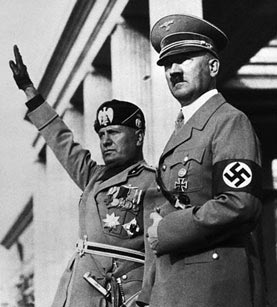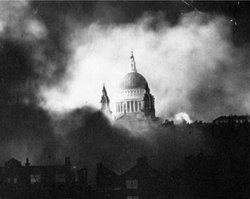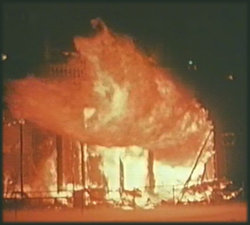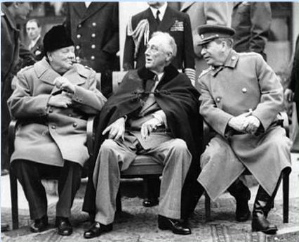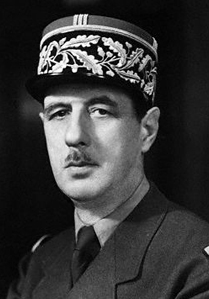European Theatre of World War II
|
|
| Contents |
Preceding events
Main article: Events preceding World War II in Europe
Main article: Causes of World War II
Germany was in debt after World War I, due to the Great Depression and the forced payments to the victors of World War I. Germans wanted a leader that would take them out of the Depression. Meanwhile, Benito Mussolini was turning Italy into a fascist state. Adolf Hitler got elected due to his promises to the German people. He had a strong sense of nationalism with him. After election, he took emergency powers and turned Germany into a totalitarian state.
After Hitler took Germany out of the League of Nations, Mussolini and Hitler formed the Rome-Berlin axis, under a treaty known as the Pact of Steel. Later, Japan would be added on, forming the Rome-Berlin-Tokyo axis, named after the capital cities of the three major powers in the axis. Japan and Germany had already signed the Anti-Comintern Pact in 1939. Other smaller powers also later joined the axis.
Outbreak of war in Europe
Edward_Rydz-Smigly.jpg
Image:Edward Rydz-Smigly.jpg
Edward Rydz-Śmigły
Polish Commander in Chief
Full-scale war in Europe began on September 1, 1939, when Nazi Germany invaded Poland, to which both Britain and France had pledged guarantees. On 3 September 1939, Britain and France declared war on Germany and British troops were sent to France, however neither French nor British troops gave any significant assistance to the Poles during the entire Polish September Campaign, and German-France border remained calm.
On September 17, the Soviet Union invaded Poland from the east and hours after that, the Polish government evacuated the country for Romania. Poland fell within 5 weeks, with her last large operational units surrendering on October 5 after the Battle of Kock.
Poland however had not capitulated and Polish government in exile continued to command a large army and world's largest resistance network, contributing to the defeat of Nazi Germany.
Despite the quick campaign in the east, along the Franco-German frontier the war settled into a quiet period. This relatively non-confrontational period between the major powers lasted until May 10, 1940, and was known as the Phony War.
Nightfall in Northern Europe
Several other countries, however, were drawn into the conflict at this time. By September 28, 1939, the three Baltic Republics felt they had no choice but to permit Soviet bases and troops on their territory. The Baltic Republics were occupied by the Soviet army on June, 1940, and finally annexed to the Soviet Union on August, 1940.
The Soviet Union offered a similar treaty to Finland at the same time, but Finland rejected it and was invaded by the Soviets on November 30. This began the Winter War. After over three months of hard fighting, and heavy losses, the Soviet Union gave up the attempted invasion. In the Moscow Peace Treaty, March 12, 1940, Finland ceded 10% of her territory. The Finns were embittered over having lost more land in the peace than on the battle fields, and over the perceived lack of world sympathy.
On April 9 1940 Germany commenced Weserübung to seize and occupy Denmark and Norway, ostensibly as a defensive maneuver against a planned (and openly discussed) Franco-British occupation of those countries aimed at controlling export of Swedish iron ore and the Northern Atlantic. After the failed British campaign in Norway, Finland and Sweden were physically cut off from the West. As a consequence, Germany put pressure on neutral Sweden to permit transition of military goods and soldiers on leave. Germany's presence proximate to northernmost Finland, and its Nickel mines, were perceived as an improvement of the strategic situation by the Finns.
War comes to the West
On May 10 the Phony War ended with a sweeping German invasion of Belgium, the Netherlands and Luxembourg, that bypassed French fortifications along the Maginot Line. After overrunning these countries Germany turned against France, entering the country through the Ardennes on May 13 - the French had made the fatal mistake of leaving this area almost totally undefended, believing its terrain to be impassable for tanks. Most Allied forces were in Flanders, anticipating a re-run of the World War I Schlieffen Plan, and were cut off from the French heartland. As a result of this, and also the superior German communications, the Battle of France was shorter than virtually all prewar Allied thought could have conceived. It lasted six weeks, including the Luftwaffe bombing of Paris June 3rd, after which France surrendered. In order to further the humiliation of the French people, Hitler arranged for the surrender document to be signed in the same railway coach where the German surrender had been signed in 1918. The surrender divided France into two parts; the Northern part occupied by Nazi Germany, and a southern part under French control, based at Vichy and referred to as Vichy France. Many French soldiers, as well as those of other occupied countries, escaped to Britain. There General de Gaulle proclaimed himself the legitimate leader of Free French forces and vowed to continue to fight. On 11 June Italy also declared war.
The fall of France left Britain and its Empire to stand alone. The British Prime Minister, Neville Chamberlain, resigned during the battle and was replaced by Winston Churchill. Fortunately for Britain, much of its army escaped capture from the northern French port of Dunkirk, where thousands of tiny civilian boats were used to ferry troops from the beaches to the waiting warships. Ironically, Hitler could have destroyed these men, but elected to follow the advice of air minister Herman Goering and allow the Luftwaffe to finish off the British. Later, these men would form the core of the army that landed at Normandy on D-Day.
The British rejected several covert German attempts to negotiate a peace. Germany massed their air force in northern France to prepare the way for a possible invasion, codenamed Operation Seelöwe, deeming that air superiority was essential for the invasion. The operations of the Luftwaffe against the Royal Air Force became known as the Battle of Britain. Initially the Luftwaffe concentrated on destroying the RAF on the ground and in the air. They later switched to bombing major British cities in the Blitz. Neither approach was successful in reducing the RAF to the point where air superiority could be obtained, and plans for an invasion were suspended.
During the Blitz, all of Britain's major industrial cites were heavily bombed. London suffered particularly, being bombed each night for several months. Other targets included Birmingham and Coventry, and strategically important cities, such as the naval base at Plymouth and the port of Kingston upon Hull. With no land forces in direct conflict in Europe, the war in the air attracted worldwide attention even as sea units fought the Battle of the Atlantic and a number of British commando raids hit targets in occupied Europe. Churchill famously said of the RAF personnel who fought in the battle: "Never in the field of human conflict has so much been owed by so many to so few".
The war in the air
Prewar doctrine had held that waves of bombers hitting enemy cities would cause mass panic and the rapid collapse of the enemy. As a result, the Royal Air Force had built up a large strategic bomber force. By way of contrast, Nazi German air force doctrine was almost totally dedicated to supporting the army. Therefore, German bombers were smaller than their British equivalents, and Germany never developed a four engined heavy bomber equivalent to the Lancaster, B-17 or B-24.
The main concentration of German raids on British cities was from autumn 1940 until spring 1941. After that a large proportion of the strength of the Luftwaffe was diverted to the war against the Soviet Union. German raids continued on a smaller scale for the rest of the war, and later the V1 Flying Bomb and V-2 ballistic missile were both used against Britain. However, the balance of bomb tonnage being dropped shifted greatly in favour of the RAF as Bomber Command gained in strength. By 1942, Bomber Command could put 1,000 bombers over one German city. From 1942 onwards, the efforts of Bomber Command were supplemented by the Eighth Air Force of the United States Army Air Force. Bomber Command raided by night and the US forces by day. On February 14 1945, a raid on Dresden produced one of the most devastating fires in history. A firestorm was created in the city, and between 25,000–35,000 people were killed. Only the raid on Hamburg (July 24, 1943), the firebombing of Tokyo and the nuclear attacks on Hiroshima (August 6, 1945) and Nagasaki (August 9, 1945) killed more people through a single attack.
The Balkans
Italy invaded Albania on April 7, 1939 and Greece on October 28, 1940, but was unable to match the Nazi German success in France. Not only did the Italians fail to conquer Greece, but under the supervision of Prime Minister Ioannis Metaxas (term April 13, 1936 - January 29, 1941) the Greeks successfully counterattacked into Albania starting from November 14, 1940.
The Kingdom of Yugoslavia, lacking true leadership of a king and instead ruled by a regency headed by Prince Pavle Karađorđević, signed the Tripartite Treaty on March 25, 1941. However, soon afterwards, after public demonstrations, a March 27 coup d'état was made by Army General Dušan Simović which took control away from the regency and distanced Yugoslavia from the fascists.
The imminent Greek victory over Italy prompted Nazi German intervention. On April 6, 1941 German forces, supported by the Italians, Hungarians and the Bulgarians, engaged in combat with the Greeks and simultaneously invaded Yugoslavia. British, Australian and New Zealand forces were hastily dispatched from Egypt to Greece, but the Allies lacked a co-ordinated strategy, were comprehensively beaten and evacuated to Crete. Advancing rapidly, Axis forces captured Athens, Greece's capital on April 27, 1941 effectively placing most of the country under occupation.
After the mainland was conquered, Nazi Germany invaded Crete in what is known as the Battle of Crete (May 20 - June 1, 1941). Instead of an amphibious assault as expected, Nazi Germany mounted a large airborne invasion. The paratroopers (fallschirmjäger) were so badly mauled in the process that an airborne operation was never again attempted by Germany during the war. However, the Germans eventually prevailed on Crete. Most of the Allied forces were evacuated to Egypt — joining King George II of Greece and the exiled Greek government of Emmanouil Tsouderos — on June 1, 1941
Once the Balkans were secure, the largest land operation in history was launched, when Germany attacked the Soviet Union. Nevertheless, the postponement of this invasion due to the Balkans would later prove fatal for Nazi Germany.
The eastern front
Main article: Eastern Front (WWII)
On June 22, 1941, Germany launched an invasion against the Soviet Union, code-named Operation Barbarossa. The leader of the USSR, Josef Stalin, had been warned repeatedly by outside sources and his own intelligence network of the impending invasion, but he ignored the warnings. Moreover, on the very night of the invasion Soviet troops received a directive undersigned by Marshal Timoshenko and General of the Army Georgi Zhukov that commanded: "do not answer to any provocations" and "do not undertake any actions without specific orders". The early weeks of the invasion were devastating for the Soviet Army. Enormous numbers of Soviet troops were encircled in pockets and fell into Nazi German hands. In addition to German troops, a few Italian, Hungarian and Romanian troops were also involved in the campaign. Finland also sent troops, but oddly, the Finns initially declared neutrality, however with both German and Soviet troops on her soil, Finland was well prepared for to join forces with Nazi Germany when the Soviet Union attacked on June 25. The following conflict from 1941-1944 is sometimes referred to as the Continuation War, as in the continuation of the Winter War.
Operation Barbarossa suffered from several fundamental flaws. The most serious of these was the logistical situation of the attack. The sheer vastness of the distances in the Soviet Union meant that Nazi Germany could only advance so far before outrunning their supply chains. By the time the German attack froze to a halt before Moscow on December 5, 1941, it literally could not go any further. There simply were not enough supplies reaching the front to conduct proper defensive operations, let alone a proper offense. The timetable that Barbarossa was planned to assumed that the Soviets would collapse before the Russian winter hit. The failure of that to happen also fatally affected Nazi German plans. Had Hitler not invaded Greece earlier in the year, the invasion would have proceeded at that time, and the Soviet Union might have collapsed.
During their long retreat, the Soviets employed a scorched earth policy. They burnt crops and destroyed utilities as they withdrew before Germany. That helped to contribute to the logistical problems that Germany experienced. More importantly for them, the Soviets also succeeded in a massive and unprecedented removal of their industry from the threatened war zone to protected areas in the East.
The extension of the campaign beyond the length that Germany expected meant that the German Army suffered hundreds of thousands of casualties in the bitter cold of the Russian winter, and from the counterattacks of Soviet units.
Even with their advance having ground to a halt due to a lack of supplies and the onset of winter, Germany had conquered a vast amount of territory, including two-fifths of the Soviet economy. Dislodging them proved difficult and eventually cost the Soviet Union dearly.
A few months after the invasion began, German troops laid siege to Leningrad (known as the Siege of Leningrad) from the North by Finnish forces, and from the South by the German Wehrmacht. Finland's C-in-C Mannerheim had halted at the River Svir and refrained from attacking the city. Hitler had ordered that the city of Leningrad must "vanish from the surface of the earth", with its entire population exterminated. Rather than storming the city, the Wehrmacht was ordered to blockade Leningrad so as to starve the city to death, while attacking it with bombers and artillery. About one million civilians died in the Leningrad siege - 800,000 by starvation. It lasted 506 days. During the winter, the only way into the city was across Lake Ladoga, between the German and Finnish lines.
Prime Minster Winston Churchill (UK),
President Franklin Delano Roosevelt (US),
and First Secretary Joseph Stalin (USSR)
After enduring the winter of 1941-1942, the German army prepared for further offensive operations. One of the major problems faced by the Nazi war machine in World War II was a shortage of oil. For this reason, Germany decided to give up on Moscow for the time being, and the summer offensive of 1942 decided to focus on the war in the south, with the target being the oil fields of the Caucasus. In a major blunder, Hitler split Army Group South into two subgroups, Army Group A which would attack the Caucasus and army group B which would advance towards the city of Stalingrad (now Volgograd).
Indecision by Hitler, dissent among the higher ranked Nazi German officers, and extended supply lines combined in a prolonged battle in the streets of Stalingrad. Germany eventually occupied over 90% of the city, but in an attempt to defeat the remaining Soviet defenders almost all Germans in the area were funneled into the ruins of the city. Months of bitter hand-to-hand combat in the ruins of the city depleted the German forces, leaving only weak Romanian and Hungarian forces to guard the flanks of the Stalingrad army group. In Operation Uranus, the Soviets easily defeated these minor axis forces as they performed an encirclement operation. The German troops remaining in the city were trapped - cut off from their supply lines and starving, they were ordered by Hitler to fight to the last man, and they displayed incredible fortitude and bravery under unbearable conditions.
Starved of food, fuel and ammunition, the pocket was gradually reduced, with the last portion surrendering on February 2nd 1943. In a cynical attempt to prevent the surrender, Hitler promoted Friedrich Paulus, Commander of 6th Army to Field Marshal, because no German of that rank had ever surrendered. Heavy losses affected both sides in the Battle of Stalingrad, one of the bloodiest battles in history. An estimated 1.5 million people perished in this battle, including 100,000 civilians.
After Stalingrad, the initiative had passed from Germany but had not yet been seized by the Soviets. A desperate counterattack in the spring of 1943 by the forces of von Manstein temporarily halted the Soviet advance, and lead to the largest tank battle in history, at Kursk. Kursk was the last major offensive by the German Army on the eastern front. The Soviets had intelligence of what was to come and prepared massive defenses in huge depth in the Kursk salient. They stopped the German armoured thrusts after a maximum penetration of 17 miles. After Kursk the Red Army never ceased being on the offensive until Berlin was captured in May 1945.
The Soviets bore the brunt of World War II; the second front in Europe did not begin until D-Day, apart from the invasion of Italy. More Soviet citizens died during World War II than those of all other countries combined. Approximately 27 million Soviets, among them more than 20 million civilians, were killed in the Nazi German invasion of the Soviet Union. Civilians were rounded up and burned or shot in many cities conquered by the Nazis. Since the Nazis considered Slavs to be "subhuman", this was ethnically targeted mass murder.
About 7 million Red Army troops died facing the Germans and their allies in the Eastern Front. The Axis forces themselves suffered about 4 million deaths, whether by combat or by wounds, disease, starvation or exposure; another several hundred thousand were seized as POWs and died in Soviet gulags.
It would be wrong however to say the Soviets fought alone. Supply convoys sailed to Soviet ports at great risk. Allied activities may have tied up only a few divisions in actual fighting, but many more were forced to guard lonely coasts against raids that never came or to man antiaircraft guns throughout Europe. It should also be mentioned that the Soviets took virtually no part in the great naval campaigns of the war, had a very limited effect on the strategic bombing offensive, and contributed very little to the defeat of Japan. Virtually their entire armed forces fought against German forces in the western regions.
It is possible, that if Hitler had not held such high goals for Germany, he might have defeated the Soviets. For instance, if Hitler had concentrated on taking Moscow, he would have succeeded in driving a fatal wedge into the heart of the Soviet Union. However, when the opportunity presented itself, Hitler transferred troops to help capture Kiev, which held no military value. Later, he tried to capture the oil in the Caucasus, and he might have, if he had not continually switched troops to where they were not needed. Incredibly, Hitler had wanted to capture all of the Soviet territory to the Ural mountains, a million square miles (2,600,000 km²) of land area. In truth, the German army could afford only to capture and hold one major area: Ukraine and the Caucasus, Moscow and central Russia, or Leningrad and northern Russia. Barbarossa proved to be Hitler's grave.
The Allies' invasion of Italy
Mussospeak.jpg
Image:mussospeak.jpg
Benito Mussolini
Italy's 'Duce'
Founder of Italian fascism.
Main article: Italian campaign
Successes in the North African desert left the Allies in complete control of the Mediterranean's southern shore and using this as a springboard Allied Forces Headquarters AFHQ started to plan an attack into what Winston Churchill referred to as the 'soft underbelly' of Europe.
The Allies first action was the capture of the island of Sicily, called Operation Husky, on 10 July, 1943. This brought to the fire a growing dissatisfaction with Mussolini. He was deposed on July 25, 1943, by the Fascist Grand Council, and placed under house arrest in an isolated mountain resort. His replacement, General Pietro Badoglio, negotiated an armistice with the Allies on September 8, 1943. Nazi Germany moved quickly into the confused situation, disarmed Italian formations and prepared to defend Italy on their own.
Allied troops landed in mainland Italy on September 3 1943, crossing from Sicily. Further landings were made at Salerno and Taranto on September 9. For more information see:Allied invasion of Italy.
A German commando raid led by Otto Skorzeny rescued Mussolini and installed him as the head of the Italian Social Republic, a Nazi puppet state in northern Italy. He continued in this role until he was captured and lynched by mobs on April 28, 1945, as the Allied forces closed in on Milan.
Germany had built a number of defensive lines through the mountains; the main one was called the Winter Line. The Allies came up against this in the winter of 1943 and were unable to break through. Amphibious landings at Anzio were made in an attempt to bypass the line: however the landing forces were contained by the Germans and the line remained intact. Finally the line was broken in the Monte Cassino.
The Allies finally entered Rome on June 4, 1944, two days before the landings in Normandy. Germany regrouped at the Gothic Line further north. After a landing in southern France in August, 1944 to threaten the German flank, on September 10, 1944 British Commonwealth forces started the attack on the line. The offensive by Allied and some Italian forces continued until Germany surrendered in Italy on April 29, 1945 two days after Mussolini's capture.
The Allies' liberation of France
Main article: Western Front (WWII)#1944 – 1945
Simultaneously with the fall of Rome came the long-awaited invasion of France. Operation Overlord put troops ashore in Normandy on June 6, 1944. A long grinding campaign two months long followed as American, British and Canadian forces were slowly built up in the bridgehead, and German forces slowly worn down. When the breakout finally did come it was spectacular, with American forces under Patton racing across France to Nazi Germany's border. The German forces that had been fighting in Normandy were trapped in the Falaise pocket.
Incessant bombing of Germany's infrastructure and cities caused tremendous casualties and disruption. Internally, Hitler survived a number of assassination attempts. The most serious was the July 20 Plot, occurring on July 20, 1944. Orchestrated by Claus von Stauffenberg and involving among others Erwin Rommel and Alfred Delp, the plot had intended to place a time bomb in a position to kill Hitler but a number of unscheduled factors led to its failure. Hitler was only slightly injured.
Operation Overlord was complemented by an invasion of southern France on August 15, 1944 codenamed Operation Dragoon. By September, 1944 three Allied Army Groups were in line against German formations in the west. There was optimism that the war in Europe might be over by the end of 1944.
An attempt was made to force the situation with Operation Market Garden (September 17 - September 24, 1944). The Allies attempted to capture bridges with an airborne assault, to open the way into Nazi Germany and liberate the northern Netherlands. Since heavier German forces than intelligence had predicted were present, the British 1st Airborne Division was almost completely destroyed.
The cold winter of 1944 combined with a poor situation for the Allies led to a stagnant situation on the western front. The Americans continued to grind away at the defenders in the Battle of Hurtgen Forest (September 13, 1944 - February 10, 1945). As long as Germany stayed on the defense, the Allies were hard-pressed to advance rapidly.
That changed when Germany mounted a major counteroffensive on December 16, 1944. The Ardennes offensive, also called the Battle of the Bulge, drove back and surrounded some American units. The Allied forces were eventually successful in driving back Germany, in what turned out to be their last major advance of the war. The battle officially ended on January 27, 1945.
The final obstacle to the Allies was the River Rhine. It was crossed in April, 1945, and the way lay open to the heart of Germany. The last German forces in the west were encircled in the Ruhr.
The end of the war in Europe
Main article: end of World War II in Europe
Mussolini, having been rescued by German paratroopers from his prison, tried to flee Italy to Switzerland with a German anti-air battalion. However, partisans recognized him and he was executed, along with his mistress, and their bodies were strung up in Milan and kicked around in the streets.
Hitler, learning of Mussolini's death, realized that the end had finally come. He remained in Berlin, even as it was encircled and slowly taken by the Soviets. On April 30, 1945, Adolf Hitler, with his wife of one day, Eva Braun, committed suicide to avoid capture. In his will Hitler appointed Karl Dönitz the new German President, but Germany lasted only 7 days longer, surrendering unconditionally on May 7, 1945.
See also
- American European-African-Middle Eastern Campaign Medal
- American European Theater of Operations
- American Mediterranean Theater of Operations
| Campaigns and theatres of World War II |
| European Theatre |
| Poland | Phony War | Denmark & Norway | France & Benelux countries | Britain |
| Eastern Front 1941-45 | Western Front 1944-45 |
| Asian and Pacific Theatres |
| China | Pacific Ocean | South-East Asia | South West Pacific | Manchuria 1945 |
| The Mediterranean, Africa and Middle East |
| Mediterranean Sea | East Africa | North Africa | West Africa | Balkans Middle East | Madagascar | Italy |
| Other |
| Atlantic Ocean | Strategic bombing | Raiding operations |
| Contemporaneous wars |
| Chinese Civil War | Winter War | Continuation War |
| Military history of World War II by nation |
| Britain | China | Egypt | Finland | France | Germany | India | Italy | Japan | Poland | Soviet Union | United States | Australia | Canada | New Zealand |


